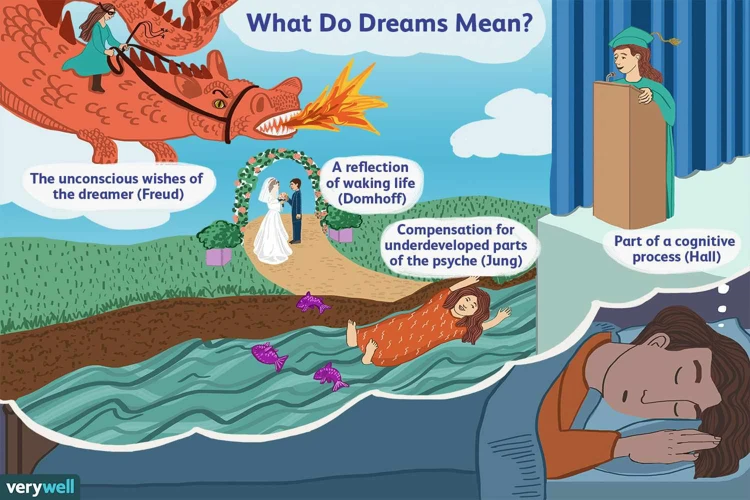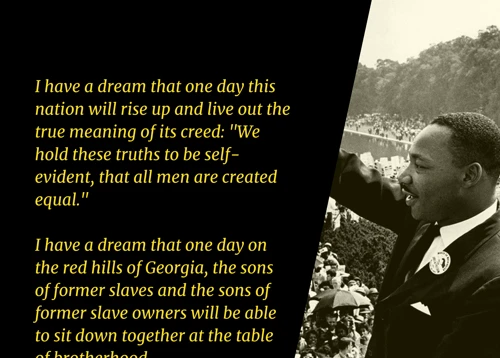The phrase “I Have a Dream” is widely recognized as one of the most powerful and iconic speeches in American history. Uttered by the prominent civil rights activist, Martin Luther King Jr., during the height of the Civil Rights Movement, this speech continues to resonate with people around the world. Its significance goes far beyond its historical context, inspiring generations and sparking conversations about equality, justice, and personal empowerment. In this article, we will delve into the meaning of “I Have a Dream,” analyzing its key messages, symbols, and impact on society. We will also explore its interpretations and discuss its continued relevance in today’s world.
The Historical Context

The “I Have a Dream” speech took place in the historical context of the Civil Rights Movement in the United States. This movement aimed to secure legal rights and equal treatment for African Americans who faced systemic racism and discrimination. It was a time of widespread protests, marches, and activism, as individuals and organizations fought for racial equality in various areas of life, including education, housing, employment, and voting rights.
Martin Luther King Jr., the iconic civil rights leader and Baptist minister, delivered the “I Have a Dream” speech on August 28, 1963, at the Lincoln Memorial in Washington, D.C. King played a pivotal role in the Civil Rights Movement, advocating for nonviolent resistance and organizing peaceful protests to combat racial injustice. His leadership and powerful oratory skills made him a prominent figure in the fight for civil rights, and his speech became one of his most famous and enduring contributions to the movement.
Civil Rights Movement
The Civil Rights Movement was a pivotal social and political movement in the United States that aimed to end racial segregation and discrimination against African Americans. It emerged in the 1950s and 1960s, fueled by the desire for equal rights and fundamental freedoms. Led by influential figures such as Martin Luther King Jr., Rosa Parks, and Malcolm X, the movement encompassed nonviolent protests, sit-ins, Freedom Rides, and marches. The movement’s goals included desegregation, voting rights, fair employment practices, and equal access to education and public facilities. Through the courage and resilience of its participants, the Civil Rights Movement brought about significant legislative changes and led to increased awareness and conversations about racial equality and justice.
Martin Luther King Jr.
Martin Luther King Jr. was a pivotal figure in the Civil Rights Movement, known for his tireless efforts to advocate for racial equality and justice. Born on January 15, 1929, in Atlanta, Georgia, King grew up in a family that was actively involved in the struggle for civil rights. Inspired by his Christian faith and the teachings of Mahatma Gandhi, King preached nonviolent resistance and believed in the power of love and forgiveness to bring about social change. As the leader of the Southern Christian Leadership Conference (SCLC), King organized and participated in numerous protests and marches, including the famous Montgomery Bus Boycott. His powerful speeches, including the “I Have a Dream” speech, resonated with people across the nation and inspired them to work towards a more just and inclusive society. Tragically, King’s life was cut short when he was assassinated on April 4, 1968, in Memphis, Tennessee. Despite his untimely death, King’s legacy lives on, and his contributions to the Civil Rights Movement continue to inspire and motivate activists striving for equality and justice today.
The Speech Itself

The “I Have a Dream” speech delivered by Martin Luther King Jr. was a masterful piece of oratory that captivated audiences with its powerful messages and evocative language. It emphasized the urgent need for racial equality and justice in America. One of the key messages of the speech was the dream of a future where racial discrimination would be eradicated, and people of all races would come together in harmony. King used vivid symbols and metaphors throughout the speech to illustrate his points and evoke a sense of hope, such as comparing the struggle for equality to cashing a check, asserting that America had defaulted on its promise of freedom for all. The speech’s emotive cadence and rhythmic repetitions, such as the famous phrase “I have a dream,” added to its impact and made it a rallying cry for social change.
Key Messages
The “I Have a Dream” speech delivered by Martin Luther King Jr. carried several key messages that resonated deeply with the audience and continue to hold significance today. Firstly, it emphasized the dream of racial equality and justice, envisioning a future where individuals are judged not by the color of their skin but by the content of their character. King also called for unity and brotherhood amongst all Americans, advocating for the end of racial segregation and discrimination. Additionally, the speech highlighted the importance of nonviolent protest and peaceful resistance in the pursuit of social change. It appealed to the moral conscience of individuals and the nation, urging them to confront the injustice of racial inequality and work towards creating a more inclusive and harmonious society.
Symbols and Metaphors
In the “I Have a Dream” speech, Martin Luther King Jr. used powerful symbols and metaphors to convey his message of equality and justice. One of the most famous symbols is the reference to the “promissory note,” which represents the unfulfilled promises of freedom and equality made in the United States Constitution and the Declaration of Independence. By using this metaphor, King effectively highlighted the discrepancy between the ideals of America and the reality faced by African Americans. Another powerful symbol is the metaphor of the “mountain of despair” and the “stone of hope,” which represents the struggles and hopes of the African American community. These vivid symbols and metaphors added depth and emotional impact to King’s speech, making it memorable and resonant.
The Bigger Picture

The “I Have a Dream” speech has had a profound impact beyond its immediate historical context. It has served as a source of inspiration for generations, reminding individuals of the importance of equality and justice. The speech exemplifies the power of words and rhetoric, as it galvanized support for the civil rights movement and brought attention to the ongoing struggle for racial equality. Additionally, it played a significant role in shaping social and political discourse, forcing people to confront issues of racism and discrimination. The “I Have a Dream” speech continues to be analyzed and interpreted in various ways, highlighting its timeless relevance and significance in the pursuit of a more just and equal society.
Inspiration for Generations
The “I Have a Dream” speech has served as a profound source of inspiration for generations. Its powerful words and impassioned delivery have resonated with individuals from all walks of life. This speech has inspired countless people to strive for a more just and equitable society. It has demonstrated the importance of standing up against injustice and fighting for the rights of marginalized communities. The speech’s call for unity, equality, and justice continues to motivate individuals to take action and work towards creating a more inclusive and fair world. Its timeless message has transcended generations, reminding us of the power of hope, determination, and collective action in the face of adversity.
Social and Political Impact
– The “I Have a Dream” speech had a profound social and political impact on American society.
– It served as a rallying cry for the Civil Rights Movement, inspiring activists and individuals to continue the fight for equality and justice.
– The speech highlighted the injustices faced by African Americans and called for an end to segregation and discrimination.
– It played a crucial role in raising awareness about the need for reform and galvanizing public support for civil rights legislation.
– The words and passion of Martin Luther King Jr. helped to shift public opinion and bring about significant changes in legislation, such as the Civil Rights Act of 1964 and the Voting Rights Act of 1965.
– The speech also sparked conversations about racial equality and challenged societal norms, leading to a greater emphasis on inclusivity and diversity in American culture.
Interpretations and Analysis

In interpreting and analyzing Martin Luther King Jr.’s “I Have a Dream” speech, several key themes emerge. The first is the pursuit of equality and justice for all individuals, regardless of their race or background. King’s passionate words and vivid imagery conveyed the urgent need to address the systemic racism and discrimination that plagued American society. Another prominent theme is racial harmony, as King emphasized the vision of a future where people of all races could come together in unity and harmony. Additionally, the speech highlighted the power of hope and belief in bringing about positive change. King’s words inspired millions to believe in the possibility of a better future, instilling a sense of optimism and determination in the hearts of those fighting for civil rights. The “I Have a Dream” speech serves as a timeless testament to the enduring importance of equality, racial harmony, and the power of hope in driving social progress.
Equality and Justice
In Martin Luther King Jr.’s “I Have a Dream” speech, the themes of equality and justice are at the forefront. King passionately articulates his dream of a future where individuals are not judged by the color of their skin but by the content of their character. He emphasizes the urgency and necessity of achieving equality, highlighting the injustices faced by African Americans at the time. Through his powerful words, King calls for an end to segregation and discrimination, advocating for equal rights, opportunities, and treatment for all people, regardless of their race. He envisions a society where justice prevails, where the promises of freedom and equality enshrined in the Constitution are fulfilled for every citizen. King’s words continue to resonate, reminding us of the ongoing struggle for equality and the importance of justice in creating a fair and inclusive society.
Racial Harmony
- Racial Harmony: One of the key themes in the “I Have a Dream” speech is the vision of racial harmony. Martin Luther King Jr. spoke passionately about his dream of a future where individuals are not judged by the color of their skin, but by the content of their character. He emphasized the importance of unity and collaboration among people of different races, envisioning a society where racial divisions are overcome and where equality and justice prevail. King’s call for racial harmony resonated with many who sought to break down barriers and foster understanding between individuals of different racial backgrounds.
Hope and Belief
In the context of the “I Have a Dream” speech, hope and belief are two overarching themes that permeate throughout Martin Luther King Jr.’s words. Through his powerful rhetoric and vivid imagery, King instilled a sense of hope in the hearts of those fighting against racial injustice. He expressed his unwavering belief in the possibility of a future where equality and justice would prevail. By painting a vision of a united and harmonious society, he inspired individuals to have faith in the power of collective action and the potential to create a better world. The speech continues to serve as a symbol of hope, reminding us that change is possible and that our beliefs can fuel the determination needed to overcome obstacles and strive for a more just society.
Personal Empowerment

The “I Have a Dream” speech goes beyond its historical and social significance to also inspire personal empowerment. One of the key aspects of the speech is its emphasis on turning dreams into reality. Martin Luther King Jr. encourages individuals to pursue their aspirations and believe in the power of their own dreams. He highlights the importance of perseverance and overcoming obstacles, reminding listeners that despite facing challenges, they have the ability to bring about change and make a difference in their own lives and the lives of others. Through his words, King instills a sense of hope, motivation, and personal agency, empowering individuals to break free from limitations and work towards a better future. The speech serves as a reminder that anyone can be an agent of change and that personal dreams can contribute to a larger collective dream of equality and justice.
Turning Dreams into Reality
The “I Have a Dream” speech serves as a powerful inspiration for turning dreams into reality. In his speech, Martin Luther King Jr. emphasized the importance of envisioning a better future and taking action to make it a reality. He spoke about the transformative power of dreams, urging individuals to not be discouraged by the challenges they face but to persevere in their pursuit of equality and justice. King’s message resonates with people today, reminding us that dreams have the potential to drive us forward and empower us to overcome obstacles. By highlighting the importance of holding onto our dreams and actively working towards them, the speech ignites a sense of determination and hope, urging individuals to turn their dreams into tangible accomplishments.
Overcoming Obstacles
Overcoming obstacles is a central theme within Martin Luther King Jr.’s “I Have a Dream” speech. King recognized the numerous challenges faced by African Americans in their struggle for equality and justice. He acknowledged the history of slavery, segregation, and discrimination that had created immense barriers for African Americans. However, his speech emphasized the importance of perseverance and determination in the face of these obstacles. King spoke of a vision where individuals would not be judged by the color of their skin, but by the content of their character. His message inspired millions to rise above the challenges they faced and continue working towards a society where equal opportunities and rights are afforded to all. By highlighting the theme of overcoming obstacles, King encouraged individuals to remain steadfast in their pursuit of justice and equality, and he has continued to inspire generations to never give up on their dreams.
Legacy and Relevance Today

– Continued Struggle for Equality: The legacy of the “I Have a Dream” speech is evident in the ongoing struggle for equality and social justice. Despite significant progress, there are still disparities and injustices in society based on race, gender, and other factors. The speech serves as a reminder of the work that remains to be done in creating a truly equal and inclusive society.
– The Power of Words: The “I Have a Dream” speech showcases the power of words to inspire and ignite change. The eloquence and passion with which Martin Luther King Jr. delivered his message resonated deeply with those who heard it and continues to move hearts and minds today. It reminds us of the importance of using our words effectively to advocate for justice and bring about positive change.
– Inspiration to Dream: The speech continues to inspire individuals to dream and envision a better world. It encourages people to imagine a future where equality, justice, and love are the guiding principles. The “I Have a Dream” speech reminds us of the power of hope and belief in shaping a better reality and inspires us to take action to turn those dreams into a tangible manifestation.
– Pursuing Personal Dreams: The “I Have a Dream” speech not only speaks to societal change but also emphasizes personal empowerment. It encourages individuals to pursue their own dreams and aspirations, regardless of the obstacles they may face. It serves as a reminder that every individual has the power to make a difference in their own lives and the lives of others through determination and perseverance.
Continued Struggle for Equality
The “I Have a Dream” speech continues to resonate today, as the struggle for equality persists. While progress has been made since the Civil Rights Movement, the fight against discrimination and injustice is far from over. The speech serves as a reminder that the dream of a society where all individuals are treated equally and have access to the same opportunities is still a work in progress. It calls on us to continue advocating for social and racial equality, to address systemic issues that perpetuate inequality, and to actively work towards creating a more inclusive and just society. The legacy of Martin Luther King Jr. and his powerful words inspire us to keep pushing for change and to never lose sight of the dream of equality for all.
The Power of Words
The “I Have a Dream” speech showcased the immense power of words to inspire and evoke change. Martin Luther King Jr.’s passionate and eloquent delivery captivated the audience and left a lasting impact on society. His words resonated far beyond the moment, igniting a collective desire for equality and justice. The speech demonstrated that words have the ability to shape minds, mobilize communities, and challenge the status quo. It illustrated the potential of language to promote understanding, empathy, and unity, highlighting the importance of effective communication in social and political movements. The legacy of the “I Have a Dream” speech stands as a testament to the enduring power of words to shape the course of history.
Inspiration to Dream
The “I Have a Dream” speech has served as a powerful source of inspiration for individuals around the world. It encourages people to dream and envision a better future, not only for themselves but for their communities and society as a whole. Here are a few ways in which the speech has inspired individuals to dream:
1. Encouraging Dreamers: Martin Luther King Jr.’s speech urges individuals to embrace their dreams and aspirations. It reminds us that dreams have the power to bring about positive change and that every person has the potential to make a difference.
2. Pursuing Personal Dreams: The speech inspires individuals to pursue their personal dreams, no matter how big or small. It reminds us that dreams are not limited by societal barriers and that we should strive to fulfill our own potential.
By highlighting the importance of dreams and their potential to transform lives, the “I Have a Dream” speech continues to motivate individuals to persevere, advocate for change, and work towards a more inclusive and equitable society.
Encouraging Dreamers
The “I Have a Dream” speech has served as a source of inspiration for dreamers of all backgrounds. Its powerful and uplifting message encourages individuals to envision a better future and work towards achieving their aspirations. Martin Luther King Jr.’s words not only spoke to the struggle for racial equality but also resonated with anyone who had a dream of their own. By sharing his vision of a world where people are judged by their character and not the color of their skin, King instilled a sense of hope and belief in the hearts of those who longed for a more just and equal society. His speech continues to encourage dreamers to pursue their goals, overcome obstacles, and strive to make their dreams a reality, regardless of their race, gender, or background.
Pursuing Personal Dreams
Pursuing personal dreams is an essential theme embedded within Martin Luther King Jr.’s “I Have a Dream” speech. While the speech primarily addressed the struggle for racial equality and justice, it also carried a broader message of empowerment and the importance of individuals striving to achieve their own aspirations. King spoke of the potential for a future where everyone, regardless of their race, would have the opportunity to pursue their dreams. This message resonates with individuals today, reminding them of the importance of setting goals and working towards their own personal aspirations, regardless of the obstacles they may encounter. By highlighting the significance of pursuing personal dreams, King’s speech continues to inspire and encourage individuals to reach for greatness.
Conclusion
In conclusion, the phrase “I Have a Dream” holds immense significance in American history and beyond. Martin Luther King Jr.’s powerful speech during the Civil Rights Movement continues to inspire and motivate people around the world. Its key messages of equality, justice, and personal empowerment resonate strongly today. The speech’s impact on society and its interpretations as symbols of hope, racial harmony, and belief are testament to its enduring legacy. As we reflect on the meaning of “I Have a Dream,” we are reminded of the ongoing struggle for equality and the power of words to bring about positive change. This iconic speech encourages dreamers to pursue their aspirations and serves as a reminder that personal dreams can be transformed into reality. By understanding the historical context and the significance of this speech, we can find inspiration and strength to continue the fight for a more just and equal society.
Frequently Asked Questions
FAQs about the Meaning of “I Have a Dream”
1. What was the purpose of the “I Have a Dream” speech?
The purpose of the speech was to advocate for racial equality and justice and to inspire people to take action against discrimination.
2. Why did Martin Luther King Jr. choose the phrase “I Have a Dream”?
The phrase “I Have a Dream” was chosen to highlight King’s vision for a future where racial harmony and equality exist, and to inspire hope in the hearts of his audience.
3. Where did Martin Luther King Jr. deliver the “I Have a Dream” speech?
The speech was delivered at the Lincoln Memorial in Washington, D.C., during the historic March on Washington for Jobs and Freedom.
4. How did the “I Have a Dream” speech contribute to the Civil Rights Movement?
The speech served as a powerful rallying cry for civil rights activists, galvanizing support for the movement and bringing national attention to the fight against racial inequality.
5. What are some key messages conveyed in the “I Have a Dream” speech?
Key messages include the call for racial equality, the importance of unity, the rejection of racial prejudice, and the belief in the power of peaceful protest and nonviolent resistance.
6. What are some symbols and metaphors used in the speech?
Symbols and metaphors include references to the Emancipation Proclamation, the Constitution, the Declaration of Independence, and the “table of brotherhood,” among others, to emphasize equality and justice.
7. How did the “I Have a Dream” speech inspire future generations?
The speech inspired future generations by instilling a sense of hope, determination, and the belief that change is possible through collective action and the power of peaceful protest.
8. What social and political impact did the speech have?
The speech contributed to the passage of the Civil Rights Act of 1964 and the Voting Rights Act of 1965, which marked significant milestones in the progress towards racial equality and an end to segregation.
9. How is the speech interpreted in terms of equality and justice?
The speech is interpreted as a powerful call for equal rights and justice for all, regardless of race, and a reminder of the ongoing struggle to achieve true equality in society.
10. How does the “I Have a Dream” speech continue to resonate today?
The speech continues to resonate today as a reminder of the progress made in the fight for racial equality, while also highlighting the ongoing need for social justice and the importance of unity and compassion in society.


